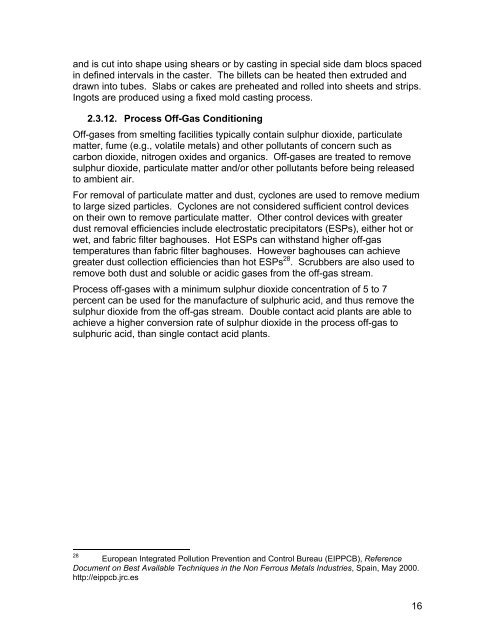(MERAF) for the Base Metals Smelting Sector - CCME
(MERAF) for the Base Metals Smelting Sector - CCME
(MERAF) for the Base Metals Smelting Sector - CCME
Create successful ePaper yourself
Turn your PDF publications into a flip-book with our unique Google optimized e-Paper software.
and is cut into shape using shears or by casting in special side dam blocs spaced<br />
in defined intervals in <strong>the</strong> caster. The billets can be heated <strong>the</strong>n extruded and<br />
drawn into tubes. Slabs or cakes are preheated and rolled into sheets and strips.<br />
Ingots are produced using a fixed mold casting process.<br />
2.3.12. Process Off-Gas Conditioning<br />
Off-gases from smelting facilities typically contain sulphur dioxide, particulate<br />
matter, fume (e.g., volatile metals) and o<strong>the</strong>r pollutants of concern such as<br />
carbon dioxide, nitrogen oxides and organics. Off-gases are treated to remove<br />
sulphur dioxide, particulate matter and/or o<strong>the</strong>r pollutants be<strong>for</strong>e being released<br />
to ambient air.<br />
For removal of particulate matter and dust, cyclones are used to remove medium<br />
to large sized particles. Cyclones are not considered sufficient control devices<br />
on <strong>the</strong>ir own to remove particulate matter. O<strong>the</strong>r control devices with greater<br />
dust removal efficiencies include electrostatic precipitators (ESPs), ei<strong>the</strong>r hot or<br />
wet, and fabric filter baghouses. Hot ESPs can withstand higher off-gas<br />
temperatures than fabric filter baghouses. However baghouses can achieve<br />
greater dust collection efficiencies than hot ESPs 28 . Scrubbers are also used to<br />
remove both dust and soluble or acidic gases from <strong>the</strong> off-gas stream.<br />
Process off-gases with a minimum sulphur dioxide concentration of 5 to 7<br />
percent can be used <strong>for</strong> <strong>the</strong> manufacture of sulphuric acid, and thus remove <strong>the</strong><br />
sulphur dioxide from <strong>the</strong> off-gas stream. Double contact acid plants are able to<br />
achieve a higher conversion rate of sulphur dioxide in <strong>the</strong> process off-gas to<br />
sulphuric acid, than single contact acid plants.<br />
28<br />
European Integrated Pollution Prevention and Control Bureau (EIPPCB), Reference<br />
Document on Best Available Techniques in <strong>the</strong> Non Ferrous <strong>Metals</strong> Industries, Spain, May 2000.<br />
http://eippcb.jrc.es<br />
16
















